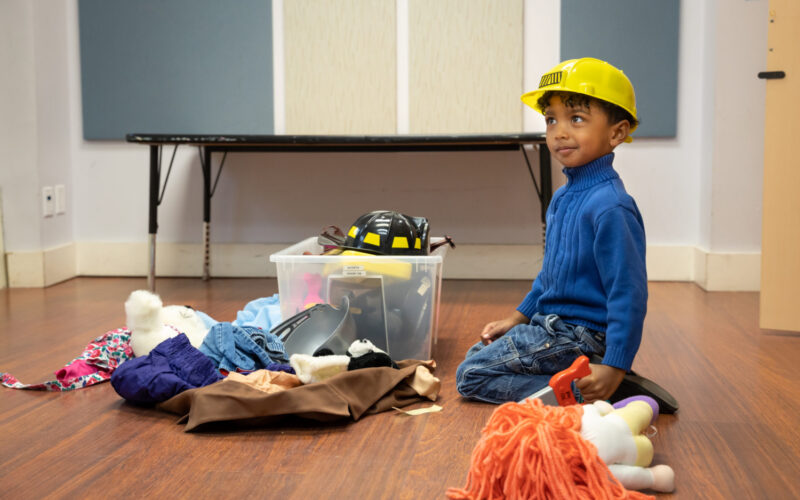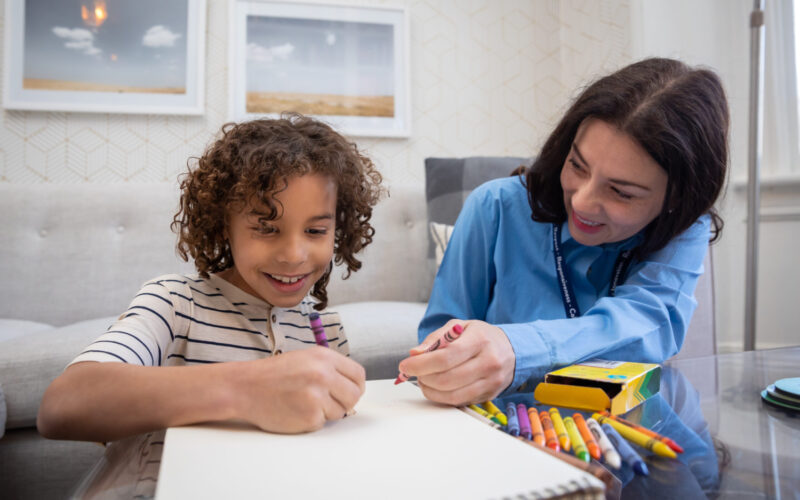Children with autism often have difficulty regulating their emotions and may display challenging behaviours that manifest in a variety of ways, such as non-compliance, repetitive vocalizations or physical aggression.
The repercussions can be felt by both children and caregivers. Children and teens may experience struggles in their daily lives, reduced access to social and educational opportunities, and difficulties at school, home and in public settings. For caregivers, the challenging behaviours of an autistic child leads to increased stress, isolation, and burnout, and can negatively impact relationships with other household family members.
What is a challenging behaviour?
Challenging behaviours can include actions that disrupt the child’s own ability to learn, interferes with the daily life of others (for example, yelling at school, which hampers other children’s ability to listen), or is harmful to the child or others.
Challenging behaviours can include:
- Property destruction (throwing or breaking items)
- Self-injurious behaviour (head banging, hitting or biting oneself)
- Aggression toward others (hitting, kicking or biting others)
- Shouting or swearing
- Sexualized behaviour in public
- Non-compliance or protesting to instructions
- Pica (ingesting non-edible objects)
- Obsessive or ritualistic behaviours
Why do challenging behaviours occur?
Challenging behaviours are driven by a need that the child is trying to meet. Behaviour analysts assess the following four functions of behaviour when trying to identify the reason behind a challenging behaviour:
- Escape or avoidance (for example, yelling and screaming when faced with a difficult math problem in school, which leads to a teacher telling the child they can skip it)
- Access to attention (for example, engaging in disruptive behaviour to get a parent’s attention, whether positive or negative)
- Access to tangibles (for example, engaging in disruptive or self-injurious behaviour to gain access to something the child wants, like an iPad)
- Sensory stimulation (for example, rocking back and forth or engaging in other behaviours that provide the child with a desirable sensory input)
Strategies for caregivers: how to manage challenging behaviours
- Educate yourself: become knowledgeable about the functions of behaviour and why a behaviour is occurring.
- If the function of behaviour is escape or avoidance (e.g., avoiding a task or activity) you may want to try:
- Teach your child how to ask for a break. This can mean teaching them how to verbalize this appropriately or how to use a picture card that indicates a break.
- Use a visual schedule that shows when an activity ends and what comes next, so the child sees that a fun activity follows a less enjoyable one
- Modify the task to make it easier or more interesting for the child, or break it down into simple steps so it’s less overwhelming for the child
- If the function of behaviour is sensory seeking you may try:
- Look to create a more enriched environment for the child so they can meet their sensory needs throughout the day
- Teach the child to engage in a behaviour that is more socially acceptable but still meets their sensory need (for example, banging on a toy drum instead of a table)
- Reinforce behaviours that are incompatible with the challenging behaviour (for example, if a child engages in hand flapping which prevents them from listening, reinforce when they keep their hands folded, which prevents the hand flapping)
- If the function of behaviour is to get attention you may try:
- Increase positive attention throughout the day
- Teach the child how to get attention appropriately (for example, if they yell or hit, teach them how to tap someone on the shoulder or say “excuse me”)
- If the function of behaviour is to gain access to tangible items you may try:
- Teach the child to request items in a more appropriate way
- Give transitional warnings to help prepare a child when they need to give up a preferred item (for example, using countdowns or a timer so they know how much time they have left with an item)
- When it comes to dealing with challenging behaviour, broadly speaking, consistency is important. This means the same strategies should be applied in different environments, including at home, at school, and in public.
- While consistency is important, caregivers can modify strategies in specific scenarios. For example, at home, caregivers may ignore mild disruptive behaviour to avoid reinforcing it if the child is engaging in the behaviour for attention. However, in public, caregivers may choose to leave the setting (for example, a park or mall) when mild disruptive behaviour occurs to avoid accidental attention being provided to the child by bystanders.
Tips for caregivers
- When caregivers take care of themselves, they’re better equipped to care for their child; find ways to reduce stress levels and take time to recharge.
- Openly communicate with all individuals involved in the child’s life (e.g. daycare staff, teachers, family members and clinicians.) Touch base regularly about the child’s progress and any changes (e.g. strategies that are working or not working, changes in treatment protocol, etc) to ensure consistency across all environments.
- Be aware of your own behaviour. Caregivers have an important role to play when it comes to modeling positive behaviour for their children.
- Having the right team in place is critical to support a decrease in a behaviour as well as teach a child new skills. The team may include board-certified behaviour analysts, psychiatrists, speech-language pathologists, occupational therapists, psychologists and case managers. The team should also include caregivers and the autistic individual.
Resources & support
- Foundational Family Services are available to any family registered in the Ontario Autism Program (OAP). Services include specialized workshops, access to a family support coach and parenting programs.
- Surrey Place’s core clinical services for autistic individuals include intensive behavioural programs, applied behaviour analysis group-based and individual support programs.
- Surrey Place offers comprehensive day treatment in the Treatment Research and Education for Autism and Developmental Disorders (TRE-ADD) program. Children and youth with autism, as well as their families, can receive a variety of services from a team of professionals.
- Surrey Place offers an Urgent Response Services for children with autism who are in crisis and at risk of harming themselves or others.
- For children who attend school, caregivers can access counsellors, speech-language pathologists and occupational therapists through the school system.
Want to Access Autism Services?
Call our Children & Youth Intake 1-833-575-KIDS (5437)


